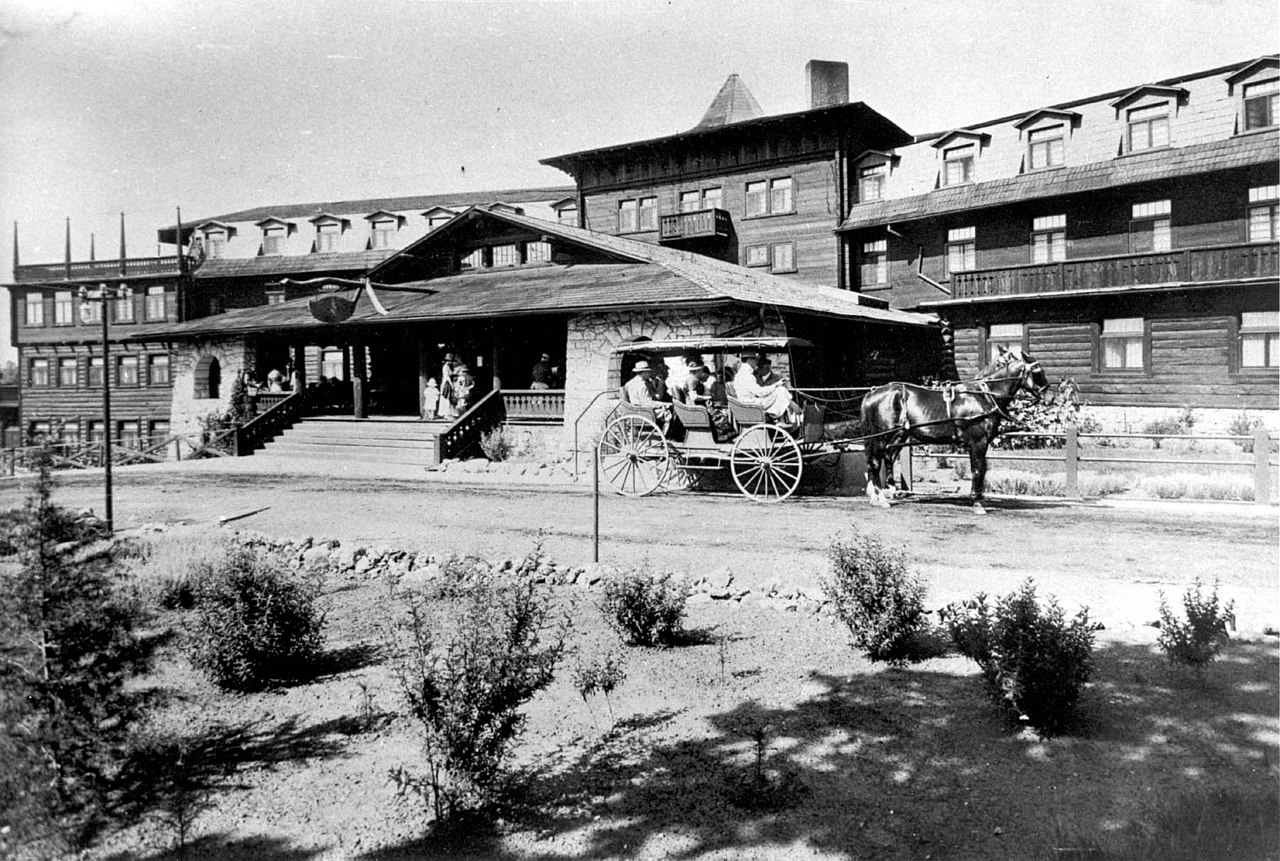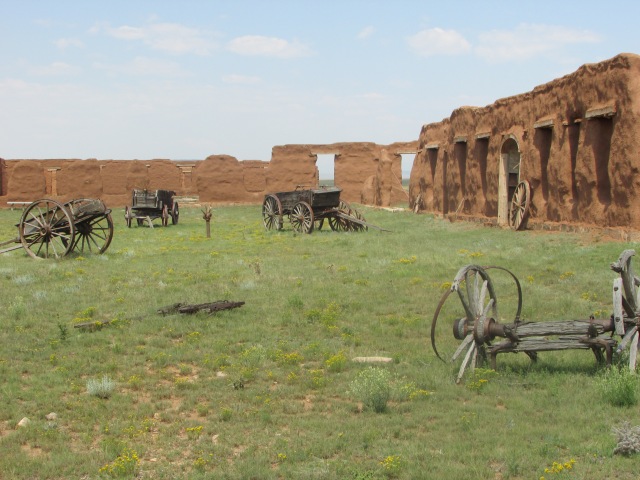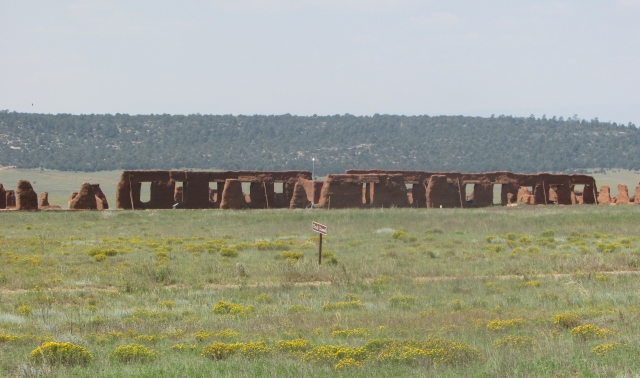Harvey Houses, which were hotels and restaurants, served train travelers and locals for years along the Atcheson, Topeka and Santa Fe (ATSF) Railroad lines across the United States. Founder Fred Harvey came up with the idea while providing food service in railroad dining cars.

Our first Harvey House experience was the fabulous El Tovar Hotel at Grand Canyon National Park. A second Harvey House at the Grand Canyon is Bright Angel Lodge. Another one closer to home is located about 15 miles away from us in Slaton, Texas and is now a bed and breakfast. Though with that said, we are dedicating this post to the Belen Harvey House Museum in Belen, New Mexico. We would also like to recognize Heide, our lovely guide who taught us so much about Harvey House history.

Where is it?
The Belen Harvey House Museum is located at 104 North 1st Street in Belen, New Mexico. Belen, which is the Spanish name for Bethlehem, is 34 miles south of Albuquerque on I-25. Access the museum’s website here.

Fred Harvey
Having immigrated from England in 1853 at the age of 17, Fred Harvey got a job as a dishwasher in a New York City restaurant. The restaurant’s owners taught him the complexities of the food service business, and he eventually became a busboy, waiter, and then a cook. Later, after working for a few years in a jewelry store, Fred and a partner opened their own restaurant, but the Civil War interrupted the venture. When the partner absconded with all of the profits, Fred was left holding the bag. Harvey eventually went to work for the Hanibal and St. Joseph Railroad in Missouri. After several promotions within the company, he was transferred to Leavenworth, Kansas where he remained for the rest of his life.

In 1876, Fred made a deal with the superintendent of the ATSF Railroad after noticing there were few accommodations and no restaurants near most of their depots. The railroad would buy or build the buildings and lease them to the Fred Harvey Company. In turn, he would provide restaurants, workers, and hotel accommodations in or near the depots. A simple handshake sealed the deal, and the first Harvey House opened in Florence, Kansas in 1878 ushering in an era that would span almost 90 years.  Fred Harvey died of intestinal cancer in 1901. After his death, his children and grandchildren ran the company into the 1960s. Harvey’s home in Leavenworth is now a museum.
Fred Harvey died of intestinal cancer in 1901. After his death, his children and grandchildren ran the company into the 1960s. Harvey’s home in Leavenworth is now a museum.
Mary Elizabeth Jane Colter

Fred Harvey hired Mary Colter, an architect and designer who designed many of the buildings at Grand Canyon National Park, to design his restaurants and hotels across the southwest. She remained the Fred Harvey Company’s chief architect and designer for 46 years, retiring in 1948 at the age of 79. Colter designed 21 hotels in addition to other buildings for the Fred Harvey Company, however, the Belen Harvey House was designed architect Myron Church.

Grand Canyon National Park was the railroad’s most popular destination, so Colter was hired to design several buildings for the park. She designed the Desert View Watchtower, Hermit’s Rest, Phantom Ranch, and Lookout Studio, among others, all of which are still in use today. Mary Colter also designed the dinnerware that was used exclusively in the dining cars on the ATSF Super Chief, which ran from Chicago, Illinois to Pasadena, California.

Harvey Girls
Women aged 18 – 30 were hired to serve as waitresses in Harvey Houses and to bring hospitality, beauty, and refinement to those establishments. Upon being hired, all Harvey Girls were sent to a one-month training program at the Vaughn, New Mexico Harvey House which no longer exists. Paid $17.50 per month plus tips, they worked 12-hour shifts six days a week. Uniforms plus room and board were perks of their employment. Free train travel along with Harvey House accommodations and meals during their one week per year vacations was another perk.

Recognizable by their black dresses and white aprons, these hard-working ladies lived in a dormitory in or near the hotel and even had a dorm mother. House rules were fairly strict. Men were never allowed to visit the girls’ living quarters, and the girls were strongly advised against fraternizing with the male railroad workers.

Nor could Harvey Girls converse with or flirt with the patrons. Their employment contracts purportedly contained an agreement stating that they would remain unmarried for at least one year after being hired. However, according to museum information, between 1883 and 1905 there were 8,260 marriages of Harvey Girls to railroad men, ranchers, cowboys, and fellow employees. Throughout the Harvey House era approximately 100,000 women worked as Harvey Girls.
Nothing But the Best But No Bathrooms
Insisting on nothing but the finest, Fred Harvey imported his table linens, dinnerware, and silverware from Europe. Although, interestingly, most of the Harvey Houses didn’t have public bathrooms. This was to prevent a passenger from missing or delaying a train.

Travelers had limited time in which to have a meal before reboarding the train – usually about 25 minutes – because it took about a half hour to refuel the trains. Harvey House lunch counters were casual and were great for a quick sandwich, piece of pie, or cup of coffee.

Dining rooms, on the other hand, were formal. Because time was so limited, an ingenious system was developed to ensure that travelers had time to enjoy their meals.  The 1955 menu below is from the La Fonda in Santa Fe. We have eaten there, and though it’s no longer a Harvey House they were still serving fabulous food at the time of our visit. We’re including the menu to show the delicious-sounding meals of the time.
The 1955 menu below is from the La Fonda in Santa Fe. We have eaten there, and though it’s no longer a Harvey House they were still serving fabulous food at the time of our visit. We’re including the menu to show the delicious-sounding meals of the time.

The Harvey House Legacy Lives On
At their peak, there were 84 Harvey Houses. The Grand Canyon’s El Tovar Hotel and Bright Angel Lodge are former Harvey Houses that are still in operation. La Posada opened in 1930 in Winslow, Arizona as Mary Colter’s self-proclaimed masterpiece. It is the only Harvey railroad hotel left in operation on Historic Route 66. In 2014, La Posada’s owner, Allen Allfeldt, bought the Castaneda Hotel in Las Vegas, New Mexico, which was Harvey’s first trackside hotel. After some rehabilitation, the Castaneda Hotel has reopened for overnight stays and dining.



Visiting the Belen Harvey House Museum
- Hours: 12:00 pm – 5:00 pm, Wednesday through Saturday.
- Admission is free but donations are greatly appreciated.
- Last admission to the museum is at 4:00 pm.
- Grab a bite to eat in the new Whistle Stop Cafe.
- Buy a souvenir in the gift shop.
- Watch the trains rumble by on the adjacent tracks.
- Tell Heide we said hello!

Thanks so much for joining us on our visit to the Belen Harvey House Museum. If you enjoy history and museums, you may enjoy these other wonderful destinations:
- Strawbery Banke Museum and Portsmouth, New Hampshire
- National Route 66 Museum
- National Corvette Museum
Happy, safe travels, y’all!
Mike and Kellye

As always, we strive to be as accurate with our information as possible. If we made a mistake, it was unintentional. (Hey, we’re only human!) Our opinions are our own.
©2023





 found off the Strip as well as downtown, and there are many RV campgrounds in and around the city.
found off the Strip as well as downtown, and there are many RV campgrounds in and around the city.

































 Arguably, Death Valley holds the record for the hottest temperature ever recorded on earth – 134º F in July of 1913. Badwater Basin is the lowest point in North America, sitting at 282 feet below sea level. With an average of 1.5 inches of rain per year, Death Valley also holds the honor of being the driest place in North America. We are used to hot, dry weather where we live, but the 111º F (before noon) temperature when we visited Death Valley felt like a different type of oppressive heat that seemed heavier to us for some reason. With that said, we caution you to be conscious of the weather and prepare for harsh conditions when visiting this park, especially in the late spring, summer, and early fall. Also, make sure your car is in tip-top condition before starting a road trip through Death Valley.
Arguably, Death Valley holds the record for the hottest temperature ever recorded on earth – 134º F in July of 1913. Badwater Basin is the lowest point in North America, sitting at 282 feet below sea level. With an average of 1.5 inches of rain per year, Death Valley also holds the honor of being the driest place in North America. We are used to hot, dry weather where we live, but the 111º F (before noon) temperature when we visited Death Valley felt like a different type of oppressive heat that seemed heavier to us for some reason. With that said, we caution you to be conscious of the weather and prepare for harsh conditions when visiting this park, especially in the late spring, summer, and early fall. Also, make sure your car is in tip-top condition before starting a road trip through Death Valley.








